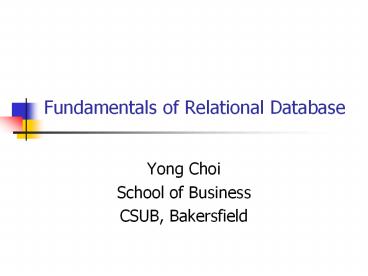Fundamentals%20of%20Relational%20Database - PowerPoint PPT Presentation
Title:
Fundamentals%20of%20Relational%20Database
Description:
Fundamentals of Relational Database Yong Choi School of Business CSUB, Bakersfield Study Objectives Understand the relational database model s basic components are ... – PowerPoint PPT presentation
Number of Views:219
Avg rating:3.0/5.0
Title: Fundamentals%20of%20Relational%20Database
1
Fundamentals of Relational Database
- Yong Choi
- School of Business
- CSUB, Bakersfield
2
Study Objectives
- Understand the relational database models basic
components are entities and their attributes, and
relationships among entities - Identify how entities and their attributes are
organized into tables - Understand concept of integrity rules of
relational database
3
Relational Model
- In the relational data model the database is
represented as a group of related tables. - The relational data model was introduced in 1970
by E. F. Codd of IBM published a paper in CACM
entitled "A Relational Model of Data for Large
Shared Data Banks". - It is currently the most popular model. The
mathematical simplicity and ease of visualization
of the relational data model have contributed to
its success.
4
Definitions of Terminology
5
Characteristics of a Relation (table)
- Two-dimensional structure with rows and columns
- A relation represent a single entity
- Each table must have an attribute to uniquely
identify each row - Column values all have same data type
- Order of the rows and columns is immaterial to
the DBMS
6
Properties of a Relation
- Based on the set theory
- 1. There are no duplicate tuples (rows).
- The body of the relation is a mathematical set
(i.e., a set of tuples), and sets in mathematics
by definition do not include duplicate elements. - If a "relation" contains duplicate tuples, then
it is not a relation.
7
Properties of a Relation
- 2. Tuples (rows) are unordered (top to bottom).
- Sets in mathematics are not ordered. So, even if
a relation A's tuples are reversely ordered, it
is still the same relation. - Thus, there is no such thing as "the 5th tuple"
or the last tuple. In other words, there is no
concept of positional addressing.
8
Properties of a Relation
- 3. Attributes (columns) are unordered (left to
right). - The heading of a relation is also defined as a
set. - There is no such thing as "5th attribute
(column)" or the last attribute.
9
Properties of a Relation
- 4. All attribute values are atomic.
- At every row-and-column position within the
table, there always exists precisely one value,
never a list of values. Or equivalently,
relations do not contain repeating groups. - A relation satisfying this condition is said to
be in First Normal Form.
10
Primary Key
- A PK is an attribute, or collection of
attributes, whose values uniquely identify each
tuple in a relation. - To being unique, a PK must be minimal (contain no
unnecessary attributes) - and must not change in value.
11
Primary Key (cont)
- One attribute, or collection of attributes, that
can serve as a PK is called candidate key, - And the remaining keys that cannot be used as a
PK are called alternate key. - Cost of PK
- SS vs. finger print
12
Candidate Key and Alternate key
State
- Could any attribute (column) serve as the PK?
- candidate key
- Is there any attribute that should not be served
as the PK? - alternate key
13
Entity Integrity Rule
- Guarantees that each entity will have a unique
identity and ensures that foreign key values can
properly reference primary key values. - Requirement
- No component of the primary key is allowed to
accept nulls. - By "null" here, we mean that information is
missing for some reason.
14
Foreign Key
- An attribute in one table whose values must
either match the primary key in another table or
be null. - Attribute FK of base relation R2 is a foreign key
if and only if it satisfies the following two
time-independent properties - Each value of FK is either wholly null or wholly
non-null. - Each non-null value of FK is identical to the
value of PK in some tuple of R1.
15
Foreign Key (cont)
16
Referential Integrity Rule
- The database must not contain any unmatched
foreign key values. - Just as primary key values represent entity
identifiers, so foreign key values represent
entity references. - The referential integrity rule simply says that
if B references A, then A must exist.
17
Referential Integrity Enforcement
- Restriction
- does not allow any deletion
- Nullification
- if value is deleted, reference value will set to
be null. - Cascading
- if value is deleted, reference value will also be
deleted. - if value is updated, reference value will also be
updated. - Default value
- if value is deleted, reference value will be have
default value, which is provided by the system.
18
Access DB Referential Integrity
- Cascade Update Related Fields
- Change of PK values in primary table ? automatic
change of FK values - Cascade Delete Related Fields
- Delete of a record in the primary table ?
automatic delete of all records in the related
table that have a matching FK value































